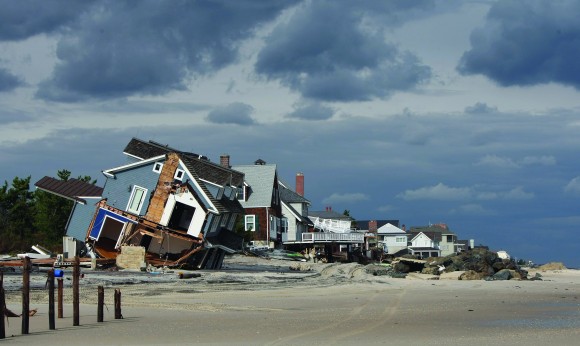A presidential task force charged with developing a strategy for rebuilding areas damaged by Superstorm Sandy has issued a report recommending 69 policy initiatives, most focused on a simple warning: Plan for future storms in an age of climate change and rising sea levels.
The report, released on Aug. 19 by the Hurricane Sandy Rebuilding Task Force, says coastal communities should assume floods are going to happen more frequently and realize that spending more now on protective measures could save money later. It calls for development of a more advanced electrical grid less likely to be crippled in a crisis, and the creation of better planning tools and standards for communities rebuilding storm-damaged areas.
“Decision makers at all levels must recognize that climate change and the resulting increase in risks from extreme weather have eliminated the option of simply building back to outdated standards and expecting better outcomes after the next extreme event,” the report says.
Some of the group’s key recommendations are already being implemented, including the creation of new flood-protection standards for major infrastructure projects built with federal money and the promotion of a sea-level modeling tool that will help builders and engineers predict where flooding might be an issue in the future.
The task force also endorsed an ongoing competition, called “Rebuild by Design,” in which 10 teams of architects and engineers from around the world are exploring ways to address vulnerabilities in coastal areas.
In its report, the task force didn’t delve deeply into what types of infrastructure might be best suited to protect the shoreline. It endorsed a greater use of natural barriers like wetlands and sand dunes, but said better tools were needed to help planners evaluate what works and quantify the long-term cost benefits of those types of green projects. It also said those projects should be planned regionally if they are to have their greatest effect.
Among other recommendations: Federal mortgage policies should be revised so homeowners can get insurance checks faster. After Sandy, many homeowners complained that mortgage banks delayed delivering their insurance payments because of bureaucratic issues.
On one vital issue related to insurance, the task force had no easy solution.
It noted that because of reforms to the financially distressed National Flood Insurance Program that began before the storm, many thousands of people who live in low-lying areas will likely see huge premium increases if they don’t lift their homes up on pilings. The task force said that for many homeowners, both options will be unaffordable. It recommended further study of that dilemma.
Topics Flood
Was this article valuable?
Here are more articles you may enjoy.



 Beryl’s Remnants Spawned 4 Indiana Tornadoes, Including an EF-3: NWS
Beryl’s Remnants Spawned 4 Indiana Tornadoes, Including an EF-3: NWS  Travelers Reverses Q2 Income Loss, Narrows Underwriting Loss
Travelers Reverses Q2 Income Loss, Narrows Underwriting Loss  Soccer Officials Arrested After Melee That Damaged Hard Rock Stadium in Miami
Soccer Officials Arrested After Melee That Damaged Hard Rock Stadium in Miami  FM Global Rebrands As FM
FM Global Rebrands As FM 


